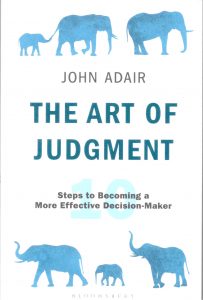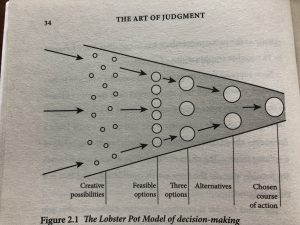The one sentence summary
Judgment is often misperceived as an unchangeable, elusive element of character but in fact it is an art – one that can be honed, developed and mastered.
Can’t be bothered to read it? Too much screen time lately? Listen to the 5-minute podcast in two parts.
WHAT THE BOOK SAYS 
- The author outlines 10 principles:
-
- Thinking to some purpose – you need a purpose to make sound judgment – purposive thinking
- Decision-making – listen, think, act
- Experience – the seedbed
- Truth – the leading star
- 5. Clear thinking – see below
- Your first vocation – is to be an engineer, soldier, doctor (domain experience)
- Leadership – your second vocation is to be a leader and rise above your domain experience
- How to share decisions – the more people share in them, the more committed they are to carrying them out
- The role of values
- Practical wisdom
- Clear thinking links 4 things together:
-
- Purpose: the ultimate end within a given context
- Aims and goals: more specific and refined. Aims are directional but open-ended. Goals are aims that have a closed end.
- 3. Objectives: specific and time bound. Target is an alternative name.
- Steps: very definite things you can do in the present to achieve objectives, usually in a sequence.
WHAT’S GOOD ABOUT IT
- We only learn when the sparks jump between ideas and experience, theory and practice. That’s when connection occurs between the general and the actual. You need both. This joins the dots between principles, third-person examples, and your own experience.
- The stages of clear thinking are:
- Interest: the thinker becomes aware of the problem and their interest is aroused
- Attention: the problem is formulated and the relevant data collected and examined
- Suggestion: possible solutions occur
- Reasoning: the consequences of each suggested solution are worked out
- Conclusion: the most satisfactory solution is adopted
- Test: the adopted suggestion is submitted to trial (R. W. Jepson, Clear Thinking, 1936)
- In the lobster pot model, you move from creative possibilities to feasible options to three options to alternatives to your chosen course of action.
- Your mental computer, your subconscious mind, is analysing, synthesizing and valuing.
- “Time spent on reconnaissance is seldom wasted.” Military proverb
- In Japan, the sunao mind sees the situation steadily as a whole. It is an untrapped and highly adaptable approach that is not swayed by the personal interests of the leader.
- Phronesis is practical wisdom – a rare combination of discretion, maturity, keenness of intellect, broad experience, extensive learning, profound thought and compassionate understanding.
WHAT YOU HAVE TO WATCH
- Not much, this is practical advice throughout.

